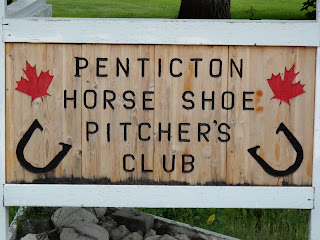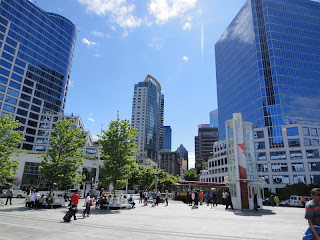My next Greyhound bus trip takes me north from Penticton, heading for a
hostel by the side of Shuswap Lake. Last week Greyhound introduced a directive
forbidding all unscheduled stop offs. The scheduled stop is 10km past the
hostel in the next town. The hostel owner, Blair, is very accommodating and she
says she will pick me up, once she has closed the hostel for the night. So at
10pm I find myself standing by the side of the road between a gas station and a
railway siding, wondering if she will come. Fortunatley she is as good as her
word and she pulls in within 15 minutes.
Her property consists of an historic general store, with two llamas in the
garden and the hostel accommodation which is in converted railway carriages. It
is situated right on the shores of Shuswap Lake and is all rather bohemian and
rustic, but very charming, in spite of the traffic noise from Highway 1. The
trans-Canadian railway runs close by and the sound of the freight trains
rumbles through my sleep.
Railway Carriage Accommodation
Inside the Caboose
Shuswap General Store
The lake is right beside the railway carriages - in fact closer now than a week agao because the water levels are
very high from all the recent rain. The dock is floating, whereas in the dry
season the water level would be 20' lower. Various communities nearby have had
flooding and the trans-Canadian Highway was washed out last week just east of
here.
Shuswap Lake
In the morning the guests sit at picnic tables outside, surrounded by
flowering orange blossom, while Blair cooks breakfast of delicious fruit
pancakes, served with maple syrup.
Blair Cooking Pancakes for Breakfast
I find I am rather limited as to what I can do from here, as there is no
public transport and many of the local hiking trails are under water from the
recent heavy rain. In my railway carriage there is a Candian woman of about my
age, with her 9 year old granddaughter and a family friend. They are going to
visit a nearby donkey sanctuary and I am delighted when they ask if I would
like to tag along. We find the donkey sanctuary at the end of a beautiful
nearby valley. It is a low-key affair and they only have visitors on a few day
a week and the lady owner takes time to show us around and introduce us to her
40 or so donkeys. When she finds out I am from Devon she tells me she is a great
admirer of the work of Elisabeth Svendson
and asks if I know of the donkey sanctuaries in Sidmouth and Ivybridge! There
is obviously a world-wide network of donkey rescuers. She has two large white
dogs on the property. The breed is quiet and soppy around people, but they
guard against bears.
Donkey Sanctuary
Bear Dog
The next day, after the pancake breakfast, Blair is going in the car to a
dairy in a nearby town to collect her order and asks if I would like to come
for the ride. On the way we chat about lots of things and I learn a lot about
what it is like to live and work in the area and something of the native
Shuswap people and the problems of integration. The diary makes its own
ice-cream in a fantastic array of flavours.
I have an enormous cone of raspberry cheesecake flavour. Now I have 2
enormous pancakes and maple syrup for breakfast and 3 hours later I have had an
enormous ice cream for lunch. With this eating and the lack of hiking, I think
I will definitely be putting on some of the weight I lost in New Zealand.
We are then going to stop at a local thrift store (charity shop) for Blair
to drop off some stuff. She explains that the store is very well supported by
the local community. It started after there was a big local forest fire and
people had to be evacuated from their homes. Local people donated all sorts of
things to help these families and there was enough to fill a hockey stadium.
When the evacuees had what they needed there was still a whole bunch of stuff
left over, so they sold everything for 25 cents. You could buy a fork, or even
a bed for 25c. Now they have certain days where you can fill a whole grocery
bag for $2. It is a bustling place where the car park is full of people driving
up and dropping off furniture.
Thrift Store
I take a look around and buy a few books - a couple of novels by Canadian
authors, as I am getting through my reading material pretty fast on the bus
trips and a funny book called, 'How to be a Canadian'. While I am standing by
the car waiting for Blair I make a start on this one and chuckle to myself.
Here's a few excepts from the first few pages that made me laugh:
There are 30 000 000 people in Canada - all of whom have, at some point
frozen their tongues to the side of a chainlink fence or flagpole. Even though
their mothers told them not to. Indeed at any given time of year, it is winter
somehere in Canada and someone, somewhere is stuck to a flagpole. 'Hap me, hap
me. Tumbuddy, pwease hap me.'
In defiance of both Einstein and the space-time continuum, hockey in Canada
now lasts sixteen months a year. The playoffs stretch things out even further.
Glaciers move faster than the standard NHL season. There are teams with
sideburns and disco hairdos still circling the ice trying to finish off the
1974 series.
I could bore you with more, and I probably will later, but for now that's
enough because maybe you have to be here, so I'll settle down in a chair in the
garden for the afternoon and giggle gently to myself.
























































